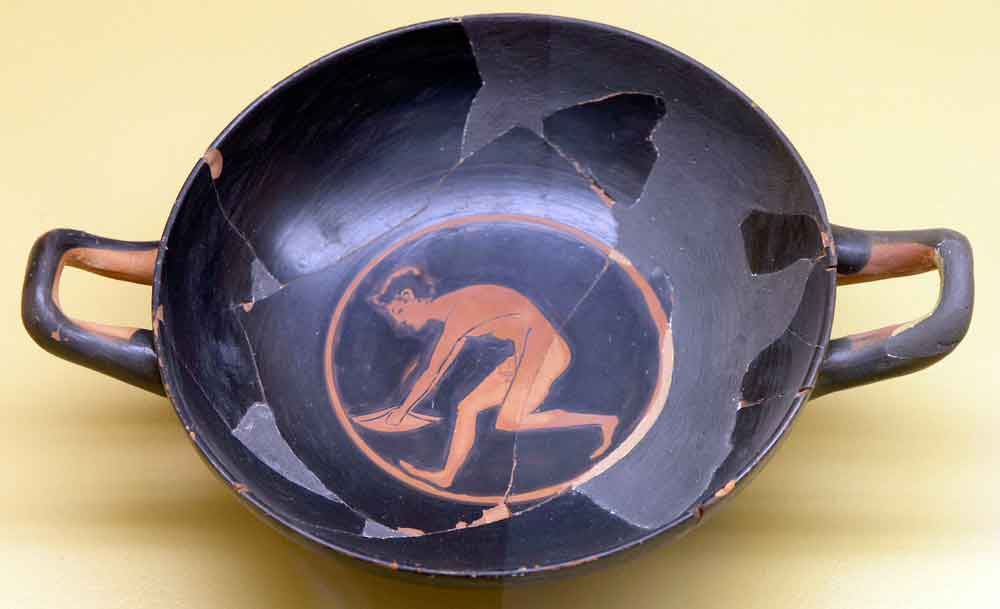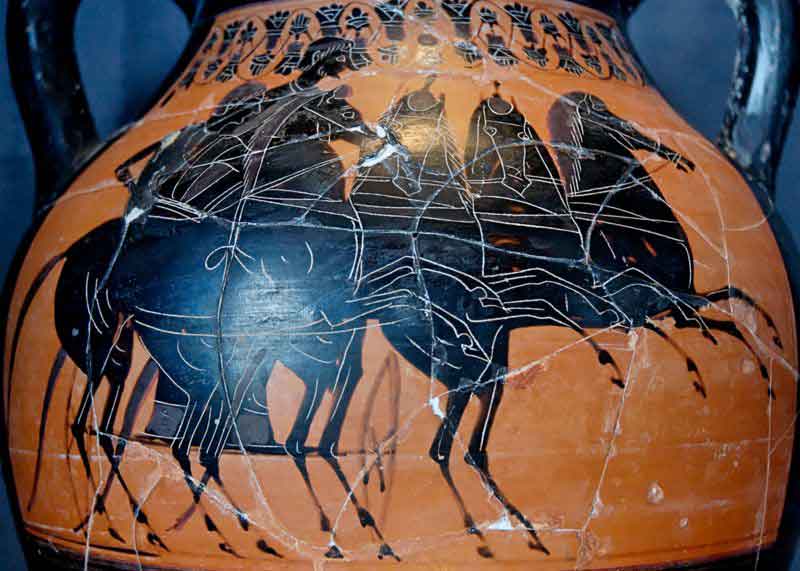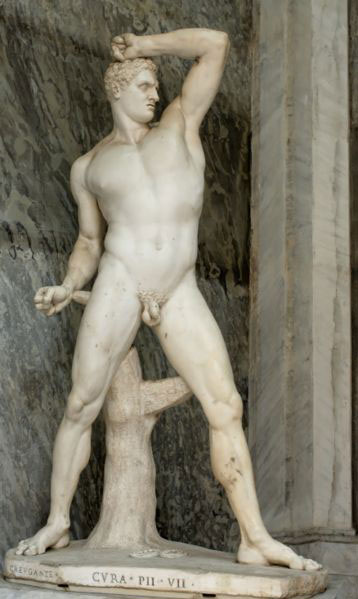One of the main themes of sport in ancient Greece is that of separation of the genders. The genders were divided and the society emphasized different traits in both males and females. A great statesman of Greece wrote on the female gender saying that "Fame will be great...for the woman whose reputation for excellence or blame is least known among males." (1) Instead of encouraging females to participate and attend athletic events, women were extremely discouraged to participate in sports and extreme laws were in effect to stop women from attending the Olympics.(1).

Adult women (those who were married) were prohibited from attending the Olympics by the laws of Ellis (the city that hosted the games). If a female participant was caught in the Olympic stadium, the city of Ellis stated that they were to be thrown into the river from Mount Typaion. (1) This law while harsh and possibly lethal was never recorded as being enforced, and in fact, there is a story of a women who had violated the Olympic game’s law and social norm.
Kallipateira, from a noble family, disguised herself as a trainer to watch her son fight and win the Olympic prize for Boxing. During the award ceremony, Kallipateria rushed out to greet her son and congratulate him. Due to her status, she went unpunished but because of her actions at every Olympics after, trainers had to enter naked (to prove their gender). (2).
Not every woman was barred from the Olympics though, as maidens and prostitutes were allowed to attend (in order to facilitate these women in finding a male as a husband or a lover). There was also a big exception to the priestess of Demeter. Even though the priestess may have been married, she was allowed to attend the event at a place of honor (it seems to be both because of her position as priestess and due to the location of her temple which was at the center of the stadium seating). (1)
No women were allowed to participate in the sporting events of the Olympics. To ensure that a male was competing, athletes would be nude when they participated in the games. There was one really big exception to this rule which allowed one woman to not only participate in the games but win twice!
Kyniska came from a wealthy family in Sparta (her father was King Archidamus II ). Spartan women could inherit land and belongings and when King Archidamus died, she inherited part of his wealth and his horses.(3) She bred these horses to the best that she could and entered them into the tethrippon, the prestigious race of horses. Under a loophole in the rules, the owner and master of the horses who won the tethrippon were the winners of that event (not the racers or the horses because the racers were usually slaves and the horses were horses). Since horse racing was costly (and because most women did not have the means to bred and care for them), the issue of gender was not raised in the winner of the horse racing events. Kyniska, in 396 BC, entered her horses into the tethrippon and to everyone’s surprise (at finding out the owner of the horses), she won. (3) Kyniska was the first women to compete and win an Olympic Sport, and she tried again at the next Olympics (four years latter) and won again. While she was denied entering the stadium for the ceremony and to collect her prize (the crown of olive leafs), she still won the Olympics (something that women were thought to not be able to compete in). She was allowed to place her statute in Zeus’s sanctuary (something that winners of the tethrippon were given the honor to do) and commissioned the inscription to read, “I declare myself the only woman in all Hellas to have won this crown.” Kyniska’s win of the “all male” Olympics set a model for further women to enter into the Olympics under the same loophole and win the event as she did. (3).Sparta, Kyniska’s city state, was also one of the very few places that encouraged women to engage in sport in general (and not just equine activities). Sparta also had a educational system for women (something much different than other areas of Greece) due to the assumption that healthy, intelligent women would produce powerful men. (1). Sparta women would engage in sporting activities all throughout the city state and many areas of Sparta would hold mini contests of wrestling and running for women (which “boys” would be allowed to attend in order to promote marriage and procreation). (1).
When women practiced sport and did athletic activity, they were subject to different rules and procedures than that of the men. One of the more noticeable differences would have been the required clothing. Men were allowed to, encouraged, and even bound to (if they were competing at the Olympics) do athletic activities in the nude. Women were required to wear chitons during such activities. (4). Pausanias describes female athletic appearances in that “their hair hangs down, a tunic reaches to a little above the knee, and they bare the right shoulder as far as the breast.” (5). This difference of clothing seems to stem from societal appreciations of male beauty over female beauty of the time. In fact, to suggest that females were to do athletic events in the same fashion as males (nude) would seem absurd to the people of Ancient Greece.
This idea is exemplified by one major discourse found in Plato’s Republic. In logically inferring that men and women should have the same educations, one speaker in the discourse brings up a big problem in this notion of equal education through the example of the gymnasiums. (6). To suggest the idea of equal education is good, but in practice it would bring ridicule due to the thought that if women were treated as equals in sport than “the most ridiculous thing of all will be the sight of women naked in the palaestra, exercising with the men, especially when they are no longer young; they certainly will not be a vision of beauty.” (6).

What this quote is trying to get at is that physically women are not something as prized as that of the male body. Males are seen as more beautiful and to think of women as practicing sport in the nude would be somewhat disgusting by Ancient Greek society. Plato responds to this idea by suggesting that even though they may be mocked for their ideas on equality, women should be treated as equal as men and that such societal prejudices will eventually go away. (6). Plato is basically saying that give equality for women some time and such concerns against women and their nakedness will go away because society will have a new norm that replaces the old one of scorn for naked women. Still Plato believed that after the age of 13, girls should wear appropriate outfits.(7).

Another area in which women were treated differently was that events for women were automatically handicapped and the intensity of the activity was lessened. When women engaged in footraces at the Olympic stadium (during the Heraea), they used the track that was 5/6th of the track that the men used. The track was 158 m for women and 192 m for males. (7). This tended to be in response to the Greek view of the inferiority of women in relations to men. Men were seen as stronger so if women were to engage in a sport, they should be given a handicap.(7).
Mentioned above is the Heraea, which should be explained. The Hereae was the female version of the Olympics and took place every fourth year. (8). Pausania described the games as follows: “the games consist of foot-races for maidens. These [women] are not all of the same age. The first to run are the youngest; after them come the next in age, and the last to run are the oldest of the maidens…[t]o the winning maidens they give crowns of olive and a portion of the cow sacrificed to Hera.” (5). While the Heraea was not as famous as the male Olympics, it still was a Greece wide contest that women could enter to showcase their abilities in foot racing. The Heraea was still a place where a woman could gain respect and honor as an athlete.
Sources also show that besides the Heraea and the Spartan women, sport was still somewhat prevalent in Ancient Greece. Homer’s Odyssey and Xenophon’s Symposium describe women playing with balls, driving chariots, swimming, and wrestling. Running, as the Heraea tested, was also very prevalent. (9). While there may have been societal pressures and divisions in sport due to gender that hindered an Ancient Greek woman from engaging in athletic (see quote above), women in ancient Greece still did many physical activities. Sparta women were an exception in the Ancient Greek times, but the majority of women still did some type of sport. While what they did was different and lessened in intensity in comparison to males, Ancient Greek women did have experience in sport. In addition, while the Olympics were denied to them by the threat of death (with the exception of the Kyniska and her horses actually winning Olympic events), women in Greece had other outlets (like the Heraea).
Citation
1)Scanlon, Thomas. Games for Girls. © 2004 by the Archaeological Institute of America www.archaeology.org/online/features/olympics/girls.htm
2)Kallipateria http://homepage.eircom.net/~mdgprimary/bsally4.htm
3)History: A female athletic champion in ancient Olympics http://www.outsports.com/os/index.php/component/content/
4)Heraea Games http://www.statemaster.com/encyclopedia/Heraea-Games
5) Ancient History Sourcebook. http://www.fordham.edu/halsall/ancient/greekgames.html
6) The Republic- Plato.
(7) Ancient Greek Olympics Gallery. http://www.bbc.co.uk/history/ancient/greeks/greek_olympics_gallery_06.shtml
8) Olympia- http://matriarchy.info/index.php?option=com_content&task=view&id=65&Itemid=113
9) Women of Ancient Greece. Bret Mills. http://www.eric.ed.gov/ERICDocs/data/ericdocs2sql/content_storage_01/0000019b/80/15/a6/0b.pdf
10) History of Women in Sports Timeline Part 1 - to 1899 http://www.northnet.org/stlawrenceaauw/timeline.htt
Picture citation
http://commons.wikimedia.org/wiki/File:Villa_Del_Casale_Bikini_modified.jpg
http://commons.wikimedia.org/wiki/File:Olympia-stadion.jpg
http://en.wikipedia.org/wiki/File:Diadoumenos-Atenas.jpg